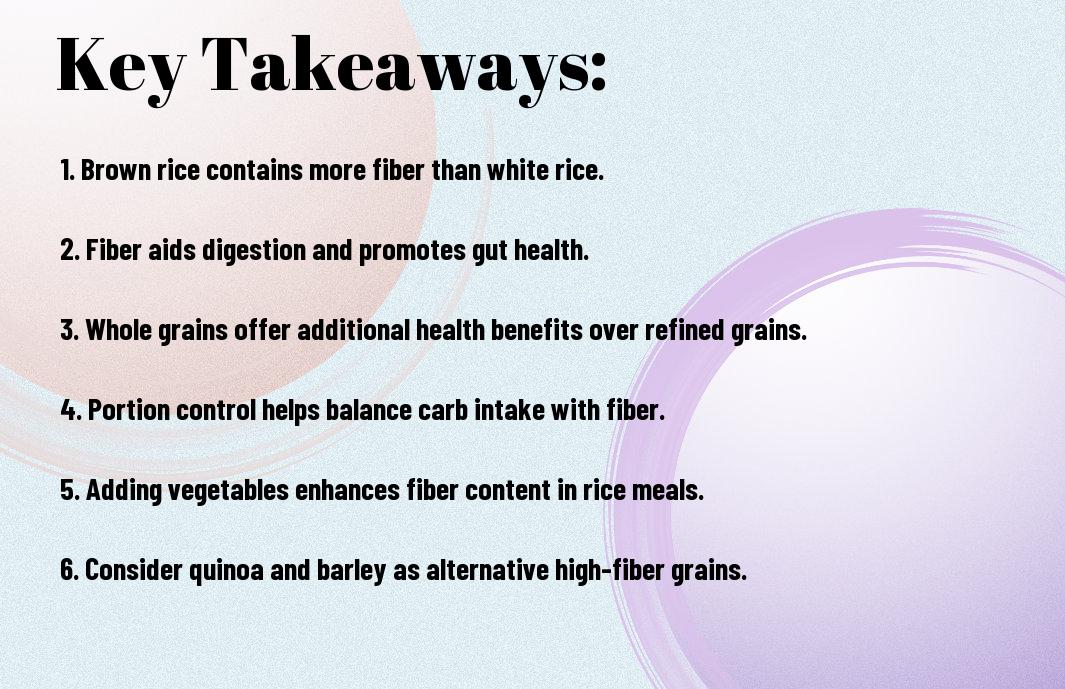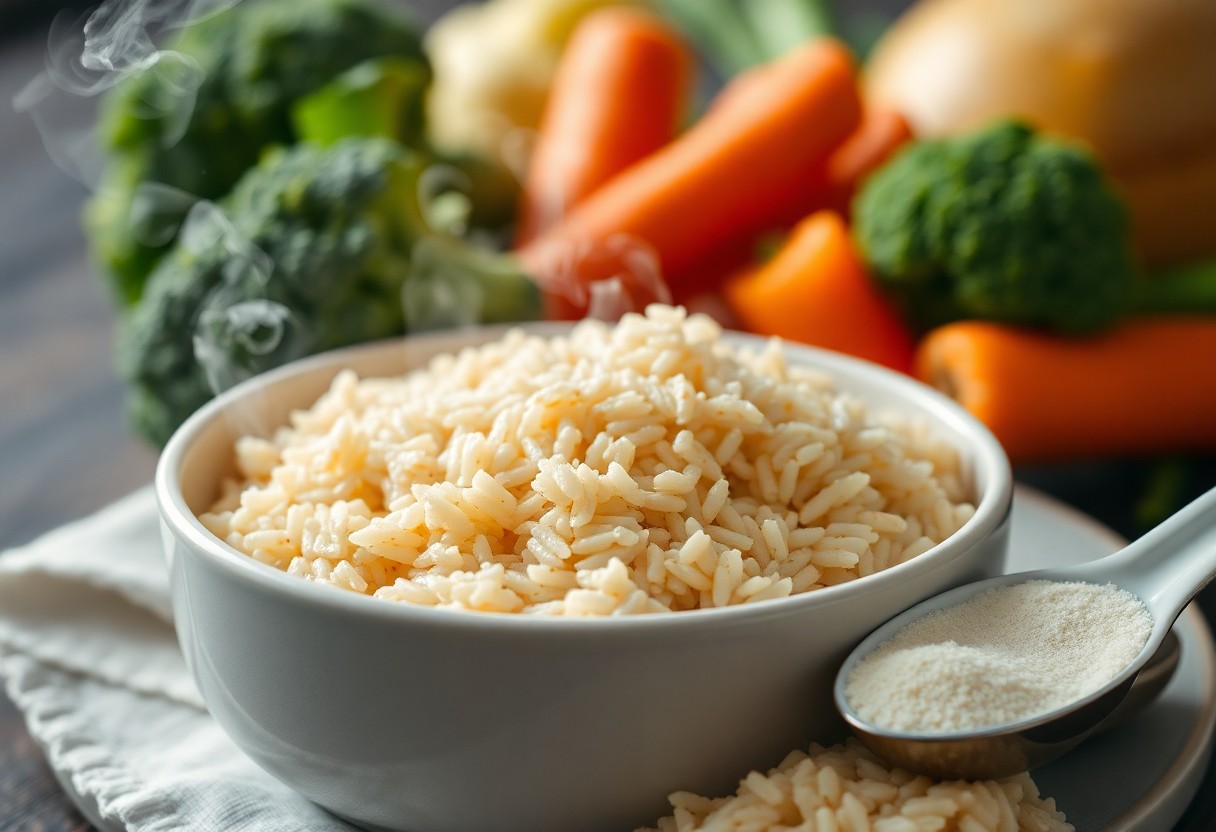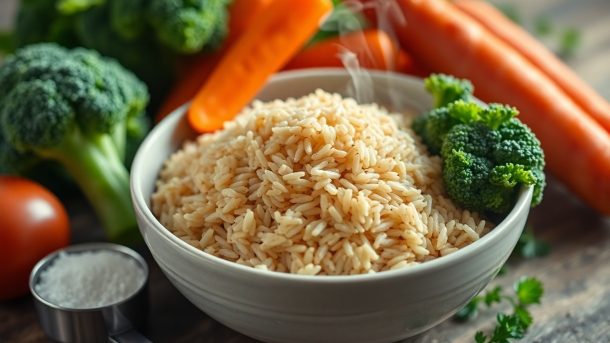Fiber plays a vital role in your digestive health, and you may wonder whether rice is a good source of it. While rice is a staple in many diets worldwide, its fiber content can vary significantly depending on the type you choose. In this blog post, we’ll explore the differences between white, brown, and other varieties of rice, helping you understand their fiber levels and how they fit into your nutrition needs.
Key Takeaways:
- White Rice: Typically low in fiber due to the removal of the bran and germ during processing.
- Brown Rice: A whole grain option that retains its bran and germ, making it significantly higher in fiber compared to white rice.
- Dietary Benefits: Incorporating high-fiber rice options can aid in digestion and provide a sense of fullness, beneficial for weight management.
Understanding Dietary Fiber
While many people tend to overlook the importance of dietary fiber, it plays a vital role in your overall health. Fiber is a type of carbohydrate that your body cannot digest, aiding in digestion, regulating blood sugar levels, and promoting a feeling of fullness, which can assist in weight management. Including a variety of fiber-rich foods in your diet can significantly enhance your well-being.
Types of Dietary Fiber
While dietary fiber is generally categorized into soluble and insoluble types, understanding these differences helps improve your dietary choices.
- Soluble Fiber: Dissolves in water; helps lower blood cholesterol and glucose levels.
- Insoluble Fiber: Does not dissolve in water; aids in digestion and adds bulk to stool.
- Fermentable Fiber: Fermented in the colon; supports gut health.
- Non-Fermentable Fiber: Passes through the digestive tract unchanged; promotes regularity.
- Functional Fiber: Added to foods or supplements; has health benefits.
Knowing the different types of dietary fiber can aid you in selecting the right foods to meet your health goals.
| Type of Fiber | Description |
| Soluble Fiber | Dissolves in water, regulating blood sugar and cholesterol. |
| Insoluble Fiber | Does not dissolve, promoting digestive health. |
| Fermentable Fiber | Supports gut health through fermentation. |
| Non-Fermentable Fiber | Promotes bowel regularity. |
| Functional Fiber | Added to foods for health benefits. |
Health Benefits of Fiber
Benefits of dietary fiber extend beyond digestion; it also supports heart health, encourages weight management, and may even lower the risk of certain diseases. Incorporating fiber into your diet can help regulate blood sugar levels, improve cholesterol profiles, and enhance gut flora.
The consumption of adequate fiber can lead to improved gastrointestinal health, reduced risk of obesity, and better control of blood sugar levels. Fiber also acts as a prebiotic, feeding the beneficial bacteria in your gut, contributing to a balanced microbiome. By prioritizing fiber-rich foods, you actively support your health and well-being.

Nutritional Profile of Rice
There’s a diverse array of rice varieties available, each with its unique nutritional profile. Generally, rice is a rich source of carbohydrates but varies in micronutrients and fiber content. While it provides energy and is gluten-free, the amount of dietary fiber can significantly differ between types, which may impact your digestion and overall health. Understanding these differences can help you choose the right rice type to suit your nutritional needs.
Comparing White Rice and Brown Rice
Fiber Content Comparison
| White Rice | 0.6 grams of fiber per 100 grams |
| Brown Rice | 3.5 grams of fiber per 100 grams |
One clear distinction between white rice and brown rice is their fiber content. White rice undergoes processing that removes the bran and germ, leading to lower fiber levels. In contrast, brown rice retains these parts, making it a more fiber-rich option, which can be beneficial for your digestive health.
Fiber Content in Different Rice Varieties
Fiber content in rice varies significantly among different types. Generally, whole grain options will yield higher fiber levels compared to their refined counterparts. Varieties such as brown rice and wild rice offer more dietary fiber, while white rice may not provide the same benefits.
Comparing various rice types can help you identify which options are best suited to your dietary goals. For instance, while brown rice boasts around 3.5 grams of fiber per 100 grams, other whole grain varieties like wild rice can contain even higher amounts. This increased fiber not only aids digestion but also supports sustained energy levels. Thus, selecting a fiber-rich variety can enhance your overall diet while providing vital nutrients.
Factors Affecting Fiber Levels in Rice
Despite its reputation as a staple food, the fiber content in rice can significantly vary. Several factors contribute to these differences:
- Type of rice (white, brown, wild)
- Growing conditions (soil quality, climate)
- Post-harvest handling
- Processing methods
- Cooking techniques
This means that not all rice provides the same fiber benefits.
Processing Methods
Above all, the way rice is processed plays a key role in its fiber content. For instance, white rice undergoes milling that removes the bran and germ, which are the parts rich in fiber. Conversely, brown rice retains these components, resulting in higher fiber levels. Understanding these distinctions can help you make healthier choices when selecting rice.
Cooking Techniques
Above the processing methods, how you cook rice can also impact its fiber levels. Different techniques, like boiling or steaming, can alter the nutritional profile slightly, but the effect on fiber is minimal compared to the type of rice selected. Opting for whole grain preparations may retain more of the natural fiber found in the grain.
With the right cooking techniques, you can maximize the fiber content of rice. For example, using a longer cooking time or a method that allows for water absorption helps keep more nutrients intact, especially when preparing whole grain varieties. Additionally, incorporating rice into a dish with fiber-rich ingredients like vegetables or beans can enhance the overall fiber content of your meal.
Health Implications of Low Fiber Intake
Keep in mind that a low fiber intake can lead to various health issues, including digestive disorders and chronic diseases. Increasing your fiber consumption is crucial for maintaining overall health. For insights on the nutritional differences, you can refer to this article on Brown Rice vs. White Rice: Nutrient Comparison.
Digestive Health
Below average fiber in your diet may result in digestive complications such as constipation or bloating. Fiber plays an crucial role in promoting regular bowel movements and can help prevent gastrointestinal discomfort.
Chronic Diseases
Before addressing the impact of low fiber intake, it’s important to recognize that insufficient fiber can increase your risk for various chronic diseases, including heart disease and diabetes. These conditions often arise from poor dietary choices.
Due to inadequate fiber consumption, your body may not effectively regulate blood sugar levels, leading to insulin resistance. Furthermore, low fiber diets can elevate cholesterol levels, increasing your risk for cardiovascular issues. Prioritizing fiber-rich foods can significantly enhance your long-term health and reduce the likelihood of developing such ailments.
Alternatives to Rice for Higher Fiber Content
Not all grains are created equal, and if you’re searching for alternatives to rice that boast higher fiber content, consider options like quinoa, barley, or farro. These whole grains are not only delicious but also provide a significant increase in fiber per serving compared to standard white rice. By incorporating these alternatives into your meals, you can easily boost your dietary fiber intake while enjoying diverse flavors and textures.
Whole Grains
Grains such as oats, brown rice, and whole wheat pasta offer more fiber than their refined counterparts. Incorporating these whole grains into your diet helps you meet your fiber goals while providing imperative nutrients. Opting for whole grains in your meals can enhance overall health and support digestive function.
Legumes and Vegetables
One of the best ways to increase your fiber intake is by including legumes and fibrous vegetables in your diet. Beans, lentils, chickpeas, and vegetables like broccoli and Brussels sprouts are not only excellent fiber sources but also packed with vitamins and minerals. These options can easily replace rice as a nutritious base for your meals, bringing added flavor and texture.
With legumes and vegetables, you have the opportunity to create satisfying and healthy dishes rich in fiber and nutrients. Incorporating these foods into your meals can enhance satiation and support digestive health, making them ideal partners in your quest for better meals. You might find that they easily adapt to various cuisines, offering you a wealth of options to explore while boosting your daily fiber intake.

Popular Myths About Rice and Fiber
After exploring the relationship between rice and fiber, you might come across several common myths that can lead to misconceptions. Many believe that all rice varieties, especially white rice, lack fiber entirely. Others think that consuming rice will negatively impact your fiber intake, causing digestive issues. These myths can mislead you regarding rice’s nutritional benefits and how it fits into a balanced diet.
Common Misconceptions
Myths surrounding rice often exaggerate its low fiber content or suggest that it’s not a good choice for a healthy diet. Some individuals may claim that rice should be eliminated from your meals if you aim to increase your dietary fiber. This can cause unnecessary fear regarding including rice in your meals.
Scientific Clarifications
Across various studies, it’s clear that rice can vary in fiber content depending on the type. While white rice has lower fiber than brown rice, it doesn’t mean you should avoid rice altogether. Understanding these distinctions can empower you to make informed choices.
But knowing the specifics can change your perspective on rice. Brown rice, for instance, retains its bran and germ, making it a higher-fiber option compared to white rice. While white rice may have lower fiber, it can still be part of a fiber-rich diet when combined with higher fiber foods like vegetables, legumes, or whole grains. By incorporating a variety of foods, you can ensure a well-rounded intake that supports your health goals.
Summing up
Upon reflecting, you should recognize that rice, particularly white rice, is not high in fiber compared to whole grains and other fibrous foods. If you’re looking to increase your fiber intake, consider incorporating brown rice or mixing rice with other high-fiber foods such as beans or vegetables. Making informed choices about your diet can significantly impact your overall health and well-being, so prioritize fiber-rich options to support digestive health.
FAQ
Q: Is rice high in fiber compared to other grains?
A: Rice is generally lower in fiber compared to whole grains like oats, barley, and quinoa. Brown rice contains more fiber than white rice because it retains the bran and germ, whereas white rice is milled and polished, stripping away much of its fiber content. Including whole grains in your diet can improve fiber intake significantly compared to white rice.
Q: How does the fiber content of brown rice compare to white rice?
A: Brown rice has a higher fiber content than white rice. A cup of cooked brown rice contains about 3.5 grams of fiber, while the same serving of cooked white rice has only about 0.6 grams of fiber. This makes brown rice a better option for those looking to increase their fiber consumption.
Q: Are there any health benefits linked to the fiber in rice?
A: Yes, the fiber found in brown rice can aid in digestion, help maintain a healthy weight, and lower the risk of developing certain diseases, such as heart disease and diabetes. Fiber helps regulate blood sugar levels and can contribute to improved gastrointestinal health.
Q: Can I still get fiber from rice-based dishes?
A: Yes, you can still incorporate fiber into rice-based dishes by adding other fiber-rich ingredients. For instance, combining brown rice with vegetables, legumes, and nuts can enhance the fiber content of the meal. Opting for dishes that include whole grains or adding high-fiber ingredients can help achieve a more balanced intake.
Q: Should I avoid rice completely if I want to increase my fiber intake?
A: There’s no need to avoid rice altogether, especially if you enjoy it. Instead, consider choosing brown rice or other whole grain alternatives and combine rice with fiber-rich foods to enhance your overall fiber intake without eliminating a staple food from your diet.



